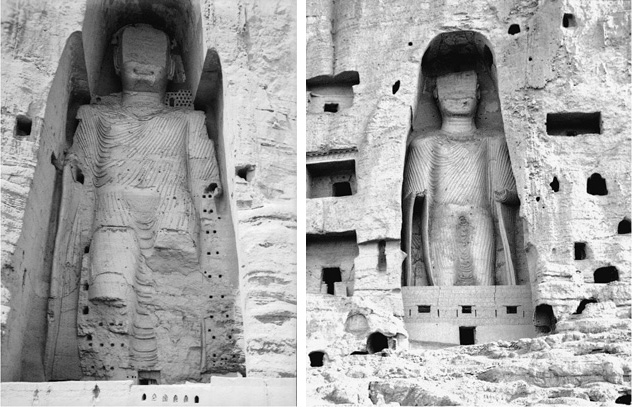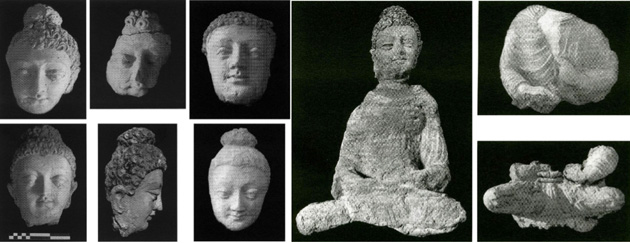|
|
| |
@The exhibition of the Bamiyan Museum is divided into following four categories; nature and history, life, Islam and Buddhism.
@At the gallery of gNature and History of Bamiyanh, the nature and history of the Bamiyan are exhibited. This gallery is the introductory room of the Bamiyan Museum, where the general information of the Bamiyan region will be introduced, and connects the exhibition rooms of the other three categories. The visitors understand the diversity of nature in the Bamiyan region, and interaction between people and nature.
@At the gallery of gLife in Bamiyanh, various goods such as clothes, carpets and kitchen tools, which show current life of the people in Bamiyan, production tools such as farming implements, transportation devices such as horse cart, and tools for cultural activities such as music instruments, will be exhibited.
@At the gIslamic Galleryh, ceramics and metal objects excavated from Shahr-i Gholghola and Shahr-i Zohak will be exhibited which show the Islamic culture in Bamiyan. Buddhism has gradually declined from 8th and 9th century in Bamiyan, then Islam has been adapted widely by the people. After that time, until when Bamiyan was invaded by Mongol and destroyed catastrophically, Bamiyan prospered as the center of this district and Islam culture and arts during the Ghaznaid dynasty, and following the Ghurid dynasty.
@Buddhism is supposed to be introduced into Bamiyan during the 2nd century, and Buddhist art and culture reached its golden age between the 5th and 8th centuries. The East and West Giant Buddhas, the seated Buddha, and the hundreds of caves decorated with brilliant mural paintings spread across the Bamiyan Great Cliff and the Bamiyan Valley. The reconstructed caves, mural paintings and decoration, replicas of the Giant Buddhas, manuscripts, and excavated objects will be exhibited. |
| |
 |
| Fragments of Islamic pottery assemblage collected by NRICPT. [NRICPT 2007: 66] |
| |
| 9-1. Exhibition design of the Buddhism collection in Bamiyan Museum |
| 9-1-1 Reconstruction of Caves at full scale |
@Cave N(a): Cave N(a) has a square plan and Laternen-decke ceiling. The mural paintings remain on the ceiling and walls even after the vandalism. Investigations of the cave by NRICPT revealed that the technique of oil paintings was applied to the mural paintings. The remarkable discovery proposes the earliest use of oil painting technique in the world. The ceiling will be reconstructed by a young researcher of the Tokyo National University of Fine Arts and Music, by using the materials and painting techniques of that time.
@Cave XI: Cave XI has an octagonal plan and a domed ceiling, which is typical of the Bamiyan caves. However, remarkable features of the cave are a niche and tambour that contained statues of Buddha. The molding is highly decorative with an arabesque design around the niche. The Cave XI will be reconstructed at full scale in the courtyard arranged at the center of the exhibition room. |
| |
  |
| Left: Current condition of the ceiling of Cave N(a) [NRICPT 2013: 167]. Right: Reconstruction of the ceiling of Cave N(a) [Reconstruction and photograph: Yuki Watanuki] |
| |
| 9-1-2. Mural Paintings |
| @The Bamiyan mural paintings were seriously damaged and looted during the civil war. Some of looted mural paintings during the civil war have been safeguarded in Japan. The NRICPT also collected fragments of mural paintings as part of their mission. In addition, the Kabul Museum has several collections related to Bamiyan. Such mural paintings and stuccos will be exhibited in the new Bamiyan Museum. |
| |
 |
| Plan, section, and ceiling of Cave N(a). [NRICPT 2013: 166]. |
| |
 |
| The plan and sections of the Cave XI [NRICPT 2013: 178]. |
| |
 |
| Top: left: Southern side of the inside Cave XI, middle: Northern side of the inside cave, right: ceiling. Bottom: left: Tambour, middle: three-dimensional designs at the tambour, right: hexagonal design at ceiling [NRICPT 2013: 178-179]. |
| |
  |
| Left 4 figures are the displaced cultural properties [Photographs: Japan Committee for the Protection of Displaced Cultural Property]. Right figure is a fragment of mural painting collected by NRICPT [NRICPT 2006]. |
| |
| 9-1-3. Materials related to the East and West Giant Buddha |
| @ICOMOS (the International Council on Monuments and Sites) Germany investigated and collected fragments of the Giant Buddhas from the Buddha niches during the safeguarding activities of the Buddha fragments. They also found objects such as wooden pegs that provide information as to the Giant Buddhas' construction. And also replicas of the East and West Giant Buddhas before their destruction will be exhibited. |
| |
| 9-2-4. Excavated objects of stupa sites |
| @The collections excavated by Prof. Zemaryalai Tarzi from the stupa sites in front of the Bamiyan Great Cliff will be exhibited in a dedicated space. Several Buddha clay heads, a seated Buddha, and other excavated objects will be displayed. |
| |
 |
| Left: A fragment of West Giant Buddha. This fragment is 2m wide, 2.3 m depth, and 1.8 m height. Middle: Pegs found from the West Giant Buddha. Right: Textiles collected from the West Giant Buddha. [Petzet 2009: 150, 205, 217] |
| |
 |
| West and East Giant Buddha at that time. Left is West Giant Buddha and right is East Giant Buddha [Photographs: National Research Institute for Cultural Properties, Tokyo] |
| |
 |
| Clay heads of a Buddha and seated Buddha excavated at Gazni [Ducoeur 2012: 134-136]. The size of the heads of Buddha is around 140mm wide and 210 mm height. |
| |
| References |
- Guillaume Ducoeur (ed.) 2012: Autour de B?miy?n, De la Bactriane helleLniseLe a` l'Inde bouddhique, Editions De Boccard.
- Michael Petzet 2009: The Giant Buddhas of Bamiyan: Safeguarding the Remains, Monuments and Sites XIX, Baessler, Hendrik Verlag.
- NRICPT 2006: Inventory for Bamiyan Mural Painting Fragment, Japan Center for International Cooperation in Conservation, National Research Institute for Cultural Properties, Tokyo.
- NRICPT 2007: Preliminary Report on the Safeguarding of the Bamiyan Site 2006: 6th and 7th Missions, Recent Cultural Heritage Issues in Afghanistan Preliminary Report Series 2, Japan Center for International Cooperation in Conservation, National Research Institute for Cultural Properties, Tokyo.
- NRICPT 2009: Preliminary Report on the Conservation of the Bamiyan Birch Bark Buddhist Manuscripts, Recent Cultural Heritage Issues in Afghanistan Preliminary Report Series 5, Japan Center for International Cooperation in Conservation, National Research Institute for Cultural Properties, Tokyo
- NRICPT 2013: Structure, Design and Technique of the Bamiyan Buddhist Caves, Recent Cultural Heritage Issues in Afghanistan, Volume 5, National Research Institute for Cultural Properties, Tokyo, Archetype Publications.
- Sigeyuki Okazaki et al. 2013: Bamiyan Museum and Culture Center for People, report for 12th Bamiyan Expert Working Group Meeting, Department of Architecture, Mukogawa Women's University.
- Shinichi Mizuno et al. 1964: Ancient Art of Afghanistan, Nihon Keizai Shimbun Inc.
|
|
| Project Members |
‘ Planning
@Kosaku MAEDA: Professor Emeritus, Wako University
@Kazuya YAMAUCHI: Head, Regional Environment Research Section,
@@National Research Institute for Cultural Properties, Tokyo
‘ Project Director; Architectural and Landscape Design
@Shigeyuki OKAZAKI: Professor Emeritus, Kyoto University,
@@Professor, Head, Department of Architecture, Mukogawa Women's University
‘ Supervision of Structure Design
@Mamoru KAWAGUCHI: Professor Emeritus, Hosei University,
@@President, KAWAGUCHI & ENGINEERS
Visiting Professor, Mukogawa Women's University
‘ Supervision of Facility Design
@Shushi SUGIURA: Professor, Mukogawa Women's University
‘ Exhibition Design
@Shumpei IWAI: Lecturer, Ryukoku Museum, Ryukoku University
‘ Site Survey
@Yoko TANIGUCHI: Associate Professor, Faculty of Humanities and Social Sciences,
@@@@@University of Tsukuba
@Shogo KUME: Research Fellow, National Research Institute for Cultural Properties, Tokyo
‘ Architectural Design and Edit
@Department of Architecture, Mukogawa Women's University
@@Noritoshi SUGIURA
@@Kazuhiko YANAGISAWA
@@Toshitomo SUZUKI
@@Hideaki TEMBATA
@@Tomoko UNO
@@Ayane ISE
@@Yuna HONGO
@@Junko MORIMOTO
@@Aya YAMAGUCHI |
|

